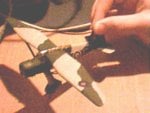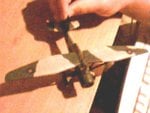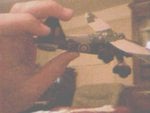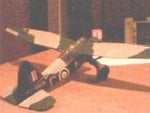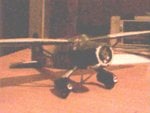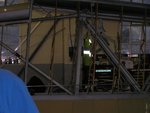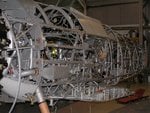jrk
Airman 1st Class
This modification of the Lysander army co-operation aircraft was either intended to repel a German invasion by strafing beaches and striking at surface vessels, or a trainer for RAF gunners. First flying in July of 1941, it was found to be very manoeverable but was never produced in quantity.

WESTLAND LYSANDER - Two-seat artillery-spotting and reconnaissance monoplane defined by Specification A.39/34 in response to Operational Requirement OR. 18. Designed under the direction of W E W 'Teddy' Fetter as Westland P.8 and two prototypes ordered in June 1935. First prototype (K6127) flown on June 15, 1936, powered by 840 hp Bristol Mercury IX and second (K6128) on December 11, 1936, with 905 hp Mercury XII. Production ordered in September 1936 to Specification 36/36, with name Westland Lysander and in Mk I and Mk II versions, respectively powered by Mercury XII and 905 hp Bristol Perseus XII engines. Perseus first flown in K6127 during 1938. Three squadrons of Mk Is and three of Mk Us equipped during 1938/39 moved to France with BEF in 1939; about 50 Westland Lysanders shot down and 30 destroyed on ground in May 1940. Other squadrons operational, 1938-39, in Egypt, Palestine and India; later served in Greece, North Africa and Western Desert, and Gibraltar. Up to 12 squadrons flying Westland Lysanders in UK in 1940, when provision made for one 20-mm cannon to be fitted on each wheel fairing, for anti-invasion role, as alternative to one 250-lb (113.5-kg) SCI (Smoke Curtain Installation, which could also imply the use of poison gas as response to enemy use of such weapons) on each stub wing. Prototype K6127 modified in 1941 to Westland P. 12 configuration with shortened fuselage ending in Frazer Nash four-gun turret for rear defence and large-span tailplane with end-plate fins based on Delanne tandem-wing principle. First flown July 27, 1941, with mock-up turret, and scrapped in 1944.
Westland Lysander I: Initial production run, with Mercury XII engine and armament of two forward-firing 0.303-in (7.7-mm) Browning machine guns in wheel fairings and one pintle-mounted Lewis or Vickers of same calibre in rear cockpit. Provision for up to 500-Ib (227-kg) of bombs on stub wings (when fitted) and four 20-lb (9-kg) bombs under rear fuselage. First production Mk I (of 169 delivered to RAF), flown spring 1938 and service deliveries began May 1938 to No 16 Sqn; one early aircraft with dual controls for conversion training. About 20 later converted to Mk I.TT (TT Mk I later) target tugs. One extra aircraft built to French order crashed in 1939 before delivery. Eighteen built for Egyptian AF delivered 1938/39, with one more ex-RAF (and one Mk III) later. Three ex-RAF Mk Is released to Finland, some operating on skis during Continuation War of 1941-44. Max speed, 229 mph (369 kmlh) at 10,000ft (3,050 m). Cruising speed, 150 mph (241 kmlh). Rate of climb, 1,650 ftlmin (8.4 mlsec). Time to 10,000 ft (3,050 m), 6.8 min. Service ceiling, 26,000 ft (7,923 m). Range, 600 mis (966 km). Empty weight, 4,065 Ib (1,844 kg). Gross weight, 7,500 Ib (3,402 kg). Span, 50 ft 0 in (15.24 m). Length, 30 ft 6 in (9.30 m). Wing area, 260sqft (24.5m2).
Westland Lysander II: Similar to Mk I but powered by Bristol Perseus XII engine. First deliveries to No 4 Sqn, 1938, and total of o 399 built (including 47 originally ordered for Indian AF, which eventually received 48 on transfer from RAF). Six built for Irish Air Corps, and 36 for Turkey in early 1940. About 25 transferred ex-RAF to Free French Air Forces in North Africa, late 1940. Some 20 later converted to Westland Lysander II.TT (TT Mk II later) target tugs, and at least 22 converted to Mk III. Mk Us served alongside Mk Is as already described. One Mk II (P9105) modified in 1940/41 to fly with Stieger-designed forward-sweep high-lift wing of parallel chord and with full-span flaps and slots, and wing-tip spoilers in place of ailerons. Orders from Latvia for 12 Mk Us and Yugoslavia for two Mk Us not fulfilled. One Mk II, ex-RAF, to Canada as pattern aircraft for local production.
Westland Lysander III: As Westland Lysander I and II, but powered by 870 hp Bristol Mercury XX or 30 engine. Deliveries began July 1940 and production totalled 350 for RAF (plus 22 Mk II conversions) before switch to Westland Lysander IIIA, which introduced a twin-gun installation in the rear cockpit, using 0.303-in (7.7-mm) Lewis guns. Westland built 347 Mk IIIAs at Yeovil and 17 more at shadow factory at Doncaster, where remainder of 500-aircraft batch cancelled. Production ended with 100 Westland Lysander IIIA.TT (TT Mk IIIA later) target tugs, with armament removed, attachments for drogue targets and a winch in the rear cockpit. Many Mk Ills also converted to target tugs. Eventually, four squadrons in Fighter Command flew Westland Lysander target tugs; others were used in India. Sixty-seven Westland Lysander III and IIIA target tugs were transferred to the FAA in the UK from 1941 onwards, and about 25 Westland Lysanders went to the USAAF in the UK, also primarily for use as target tugs. Eight Mk IIIAs to Portugal in September 1943. From initial Westland Lysander III production, nine diverted to Finnish Air Force and one to Egypt, these being aircraft originally ordered for Estonia but absorbed into RAF contracts. In Finland, Westland Lysanders flew briefly with Llv.14 in the Winter War and then with Llv. 16 in the Continuation War until
1944, frequently on skis. Westland Lysander Ills supplemented earlier marks in overseas units including those in North Africa, Madagascar and India/Burma. In the UK, they were adopted for Air-Sea Rescue role from mid-1940 onwards, carrying M-type dinghies and other survival gear on the stub wings, and eventually equipping four full squadrons. Another major role was in support of SOE operations to deliver and collect agents in enemy-occupied territory. Starting in August
1940, Special Duty Westland Lysanders were modified to have all armament removed, a 150-Imp gal (682-1) tank fitted under the fuselage and a long access ladder provided for the rear cockpit. The Westland Lysander III(SD) and IIIA(SD) had a gross weight of 10,000 Ib (4,536 kg) and endurance of over eight hours with a pilot and two passengers. They were flown successively by No 419 Flight, No 1419 Flight, No 138 and No 161 Sqns in the UK, by No 149 Sqn in North Africa and by No 357 Sqn in the Far East.
Max speed, 212 mph (341 km/h) at 5,000 ft (1,525 m). Time to 10,000 ft (3,050 m), 8.0 min. Service ceiling, 21,500 ft (6,553 m). Empty weight, 4,365 Ib (1,978 kg). Gross weight (SD), 10,000 Ib (4,536 kg). Dimensions as Mk I.
Westland Lysander (Canada): Production of Westland Lysander II initiated for RCAF in March 1938, in newly-constructed facility at Malton managed by National Steel Car Corp Ltd. One Mk II supplied ex-RAF as pattern aircraft and first of 75 built at Malton flown on August 16, 1939. Deliveries began September 1939 and used by three RCAF squadrons. Six transferred to RAF, and one converted to prototype target tug, with electric winch in rear cockpit. Further production of 150 Westland Lysander IIIA target-tugs from December 1941. RCAF also received 103 Westland Lysander IIIAs, ex-RAF, from Britain, virtually all converted to target tugs before or after reaching Canada. One Canadian Westland Lysander II was fitted experimentally with skis.

to my knowledge one lysander actually shot down an heinkel he111.
the landing speed of this aircraft was 45 mph.
WESTLAND LYSANDER - Two-seat artillery-spotting and reconnaissance monoplane defined by Specification A.39/34 in response to Operational Requirement OR. 18. Designed under the direction of W E W 'Teddy' Fetter as Westland P.8 and two prototypes ordered in June 1935. First prototype (K6127) flown on June 15, 1936, powered by 840 hp Bristol Mercury IX and second (K6128) on December 11, 1936, with 905 hp Mercury XII. Production ordered in September 1936 to Specification 36/36, with name Westland Lysander and in Mk I and Mk II versions, respectively powered by Mercury XII and 905 hp Bristol Perseus XII engines. Perseus first flown in K6127 during 1938. Three squadrons of Mk Is and three of Mk Us equipped during 1938/39 moved to France with BEF in 1939; about 50 Westland Lysanders shot down and 30 destroyed on ground in May 1940. Other squadrons operational, 1938-39, in Egypt, Palestine and India; later served in Greece, North Africa and Western Desert, and Gibraltar. Up to 12 squadrons flying Westland Lysanders in UK in 1940, when provision made for one 20-mm cannon to be fitted on each wheel fairing, for anti-invasion role, as alternative to one 250-lb (113.5-kg) SCI (Smoke Curtain Installation, which could also imply the use of poison gas as response to enemy use of such weapons) on each stub wing. Prototype K6127 modified in 1941 to Westland P. 12 configuration with shortened fuselage ending in Frazer Nash four-gun turret for rear defence and large-span tailplane with end-plate fins based on Delanne tandem-wing principle. First flown July 27, 1941, with mock-up turret, and scrapped in 1944.
Westland Lysander I: Initial production run, with Mercury XII engine and armament of two forward-firing 0.303-in (7.7-mm) Browning machine guns in wheel fairings and one pintle-mounted Lewis or Vickers of same calibre in rear cockpit. Provision for up to 500-Ib (227-kg) of bombs on stub wings (when fitted) and four 20-lb (9-kg) bombs under rear fuselage. First production Mk I (of 169 delivered to RAF), flown spring 1938 and service deliveries began May 1938 to No 16 Sqn; one early aircraft with dual controls for conversion training. About 20 later converted to Mk I.TT (TT Mk I later) target tugs. One extra aircraft built to French order crashed in 1939 before delivery. Eighteen built for Egyptian AF delivered 1938/39, with one more ex-RAF (and one Mk III) later. Three ex-RAF Mk Is released to Finland, some operating on skis during Continuation War of 1941-44. Max speed, 229 mph (369 kmlh) at 10,000ft (3,050 m). Cruising speed, 150 mph (241 kmlh). Rate of climb, 1,650 ftlmin (8.4 mlsec). Time to 10,000 ft (3,050 m), 6.8 min. Service ceiling, 26,000 ft (7,923 m). Range, 600 mis (966 km). Empty weight, 4,065 Ib (1,844 kg). Gross weight, 7,500 Ib (3,402 kg). Span, 50 ft 0 in (15.24 m). Length, 30 ft 6 in (9.30 m). Wing area, 260sqft (24.5m2).
Westland Lysander II: Similar to Mk I but powered by Bristol Perseus XII engine. First deliveries to No 4 Sqn, 1938, and total of o 399 built (including 47 originally ordered for Indian AF, which eventually received 48 on transfer from RAF). Six built for Irish Air Corps, and 36 for Turkey in early 1940. About 25 transferred ex-RAF to Free French Air Forces in North Africa, late 1940. Some 20 later converted to Westland Lysander II.TT (TT Mk II later) target tugs, and at least 22 converted to Mk III. Mk Us served alongside Mk Is as already described. One Mk II (P9105) modified in 1940/41 to fly with Stieger-designed forward-sweep high-lift wing of parallel chord and with full-span flaps and slots, and wing-tip spoilers in place of ailerons. Orders from Latvia for 12 Mk Us and Yugoslavia for two Mk Us not fulfilled. One Mk II, ex-RAF, to Canada as pattern aircraft for local production.
Westland Lysander III: As Westland Lysander I and II, but powered by 870 hp Bristol Mercury XX or 30 engine. Deliveries began July 1940 and production totalled 350 for RAF (plus 22 Mk II conversions) before switch to Westland Lysander IIIA, which introduced a twin-gun installation in the rear cockpit, using 0.303-in (7.7-mm) Lewis guns. Westland built 347 Mk IIIAs at Yeovil and 17 more at shadow factory at Doncaster, where remainder of 500-aircraft batch cancelled. Production ended with 100 Westland Lysander IIIA.TT (TT Mk IIIA later) target tugs, with armament removed, attachments for drogue targets and a winch in the rear cockpit. Many Mk Ills also converted to target tugs. Eventually, four squadrons in Fighter Command flew Westland Lysander target tugs; others were used in India. Sixty-seven Westland Lysander III and IIIA target tugs were transferred to the FAA in the UK from 1941 onwards, and about 25 Westland Lysanders went to the USAAF in the UK, also primarily for use as target tugs. Eight Mk IIIAs to Portugal in September 1943. From initial Westland Lysander III production, nine diverted to Finnish Air Force and one to Egypt, these being aircraft originally ordered for Estonia but absorbed into RAF contracts. In Finland, Westland Lysanders flew briefly with Llv.14 in the Winter War and then with Llv. 16 in the Continuation War until
1944, frequently on skis. Westland Lysander Ills supplemented earlier marks in overseas units including those in North Africa, Madagascar and India/Burma. In the UK, they were adopted for Air-Sea Rescue role from mid-1940 onwards, carrying M-type dinghies and other survival gear on the stub wings, and eventually equipping four full squadrons. Another major role was in support of SOE operations to deliver and collect agents in enemy-occupied territory. Starting in August
1940, Special Duty Westland Lysanders were modified to have all armament removed, a 150-Imp gal (682-1) tank fitted under the fuselage and a long access ladder provided for the rear cockpit. The Westland Lysander III(SD) and IIIA(SD) had a gross weight of 10,000 Ib (4,536 kg) and endurance of over eight hours with a pilot and two passengers. They were flown successively by No 419 Flight, No 1419 Flight, No 138 and No 161 Sqns in the UK, by No 149 Sqn in North Africa and by No 357 Sqn in the Far East.
Max speed, 212 mph (341 km/h) at 5,000 ft (1,525 m). Time to 10,000 ft (3,050 m), 8.0 min. Service ceiling, 21,500 ft (6,553 m). Empty weight, 4,365 Ib (1,978 kg). Gross weight (SD), 10,000 Ib (4,536 kg). Dimensions as Mk I.
Westland Lysander (Canada): Production of Westland Lysander II initiated for RCAF in March 1938, in newly-constructed facility at Malton managed by National Steel Car Corp Ltd. One Mk II supplied ex-RAF as pattern aircraft and first of 75 built at Malton flown on August 16, 1939. Deliveries began September 1939 and used by three RCAF squadrons. Six transferred to RAF, and one converted to prototype target tug, with electric winch in rear cockpit. Further production of 150 Westland Lysander IIIA target-tugs from December 1941. RCAF also received 103 Westland Lysander IIIAs, ex-RAF, from Britain, virtually all converted to target tugs before or after reaching Canada. One Canadian Westland Lysander II was fitted experimentally with skis.
to my knowledge one lysander actually shot down an heinkel he111.
the landing speed of this aircraft was 45 mph.

